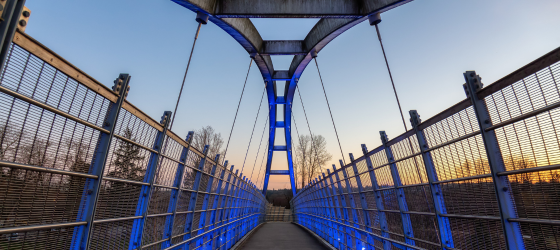$3.5 billion in funding for community connectivity!
The Neighborhood Access and Equity Grant (NAE) Program provides funds for projects that improve walkability, safety, and affordable transportation access. The program supports context-sensitive strategies and addresses existing transportation facilities that create barriers to community connectivity or negative impacts on the human or natural environment, especially in disadvantaged or underserved communities.
The program also provides funding for planning and capacity-building activities in disadvantaged or underserved communities as well as funding for technical assistance to units of local government to facilitate efficient and effective contracting, design, and project delivery and to build capacity for delivering surface transportation projects.
Funding Overview
$1.893 billion for grants to eligible entities for activities eligible under the program.
$1.262 billion for grants to eligible recipients for eligible projects in economically disadvantaged communities.
$50 million for technical assistance activities and capacity-building subgrants to units of local government, as well as FHWA operations and administration.
The Federal share of the cost of an activity carried out with a grant under the program may not exceed 80% except that the Federal share of the cost of an eligible project may be up to 100% for projects in a disadvantaged or underserved community.
Eligibility Requirements
- A State,
- A unit of local government;
- A political subdivision of a State,
- An entity described in 23 U.S.C. 207(m)(1)(E) (Federally recognized Indian Tribe);
- A U.S. territory;
- A special purpose district or public authority with a transportation function;
- A Metropolitan Planning Organization (as defined in 23 U.S.C. 134(b)(2)); or
- For grants for planning and capacity building activities in disadvantaged or underserved communities, in addition to the eligible entities described above, a non-profit organization or institution of higher education that has partnered with an eligible entity. [§ 60501; 23 U.S.C. 177(b)]
Eligible Activities
- Improve walkability, safety, and affordable transportation access through projects that are context-sensitive–
- remove, remediate, or reuse a facility described in 23 U.S.C. 177(c)(1);
- replace a facility described in 23 U.S.C. 177(c)(1) with a facility that is at-grade or lower speed;
- retrofit or cap a facility described in 23 U.S.C. 177(c)(1);
- build or improve complete streets, multiuse trails, regional greenways, or active transportation networks and spines; or
- provide affordable access to essential destinations, public spaces, or transportation links and hubs;
- Mitigate or remediate negative impacts on the human or natural environment resulting from a facility described in 23 U.S.C. 177(c)(2) in a disadvantaged or underserved community through–
- noise barriers to reduce impacts resulting from a facility described in 23 U.S.C. 177(c)(2);
- technologies, infrastructure, and activities to reduce surface transportation-related greenhouse gas emissions and other air pollution;
- natural infrastructure, pervious, permeable, or porous pavement, or protective features to reduce or manage stormwater run-off resulting from a facility described in 23 U.S.C. 177(c)(2);
- infrastructure and natural features to reduce or mitigate urban heat island hot spots in the transportation right-of-way or on surface transportation facilities; or
- safety improvements for vulnerable road users; and
- Planning and capacity building activities in disadvantaged or underserved communities to–
- identify, monitor, or assess local and ambient air quality, emissions of transportation greenhouse gases, hot spot areas of extreme heat or elevated air pollution, gaps in tree canopy coverage, or flood prone transportation infrastructure;
- assess transportation equity or pollution impacts and develop local anti-displacement policies and community benefit agreements;
- conduct predevelopment activities for projects eligible under 23 U.S.C. 177(a);
- expand public participation in transportation planning by individuals and organizations in disadvantaged communities
Deadline
Septemeber 28, 2023
